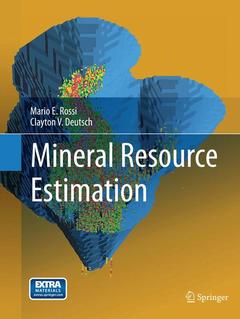Description
Mineral Resource Estimation, Softcover reprint of the original 1st ed. 2014
Authors: Rossi Mario E., Deutsch Clayton V.
Language: English
Subjects for Mineral Resource Estimation:
68.56 €
In Print (Delivery period: 15 days).
Add to cartPublication date: 04-2017
Support: Print on demand
94.94 €
In Print (Delivery period: 15 days).
Add to cartPublication date: 01-2014
332 p. · 21x27.9 cm · Hardback
Description
/li>Contents
/li>Comment
/li>
Mineral resource estimation has changed considerably in the past 25 years: geostatistical techniques have become commonplace and continue to evolve; computational horsepower has revolutionized all facets of numerical modeling; mining and processing operations are often larger; and uncertainty quantification is becoming standard practice. Recent books focus on historical methods or details of geostatistical theory. So there is a growing need to collect and synthesize the practice of modern mineral resource estimation into a book for undergraduate students, beginning graduate students, and young geologists and engineers. It is especially fruitful that this book is written by authors with years of relevant experience performing mineral resource estimation and with years of relevant teaching experience. This comprehensive textbook and reference fills this need.
1 Introduction
1.1 Objectives and Approach
1.2 Scope of Resource Modeling
1.3 Critical Aspects
1.4 Historical Perspective
1.5 References
2 Statistical Tools and Concepts
2.1 Basic Concepts
2.2 Probability Distributions
2.3 Spatial Data Analysis
2.4 Gaussian Distribution and Data Transformations
2.5 Data Integration and Inference
2.6 Exercises
2.7 References
3 Geological Controls and Block Modeling
3.1 Geological and Mineralization Controls
3.2 Geologic Interpretation and Modeling
3.3 Visualization
3.4 Block Model Setup and Geometry
3.5 Summary of Minimum, Good and Best Practices
3.6 Exercises
3.7 References
4 Definition of Estimation Domains
4.1 Estimation Domains
4.2 Defining the Estimation Domains
4.3 Case Study: Estimation Domains Definition for the Escondida Mine
4.4 Boundaries and Trends
4.5 Uncertainties Related to Estimation Domain Definition
4.6 Summary of Minimum, Good and Best Practices
4.7 Exercises
4.8 References
5 Data Collection and Handling
5.1 Data
5.2 Basics of Sampling Theory
5.3 Sampling Quality Assurance and Quality Control
5.4 Variables and Data Types
5.5 Compositing and Outliers
5.6 Density Determinations
5.7 Geometallurgical Data
5.8 Summary of Minimum, Good and Best Practices
5.9 Exercises
5.10 References
6 Spatial Continuity
6.1 Concepts
6.2 Experimental Variograms and Exploratory Analysis
6.3 Modeling 3-D Variograms
6.4 Multivariate Case
6.5 Summary of Minimum, Good and Best Practices
6.6 Exercises
6.7 References
7 Mining Dilution
7.1 Recoverable vs. In-Situ Resources
7.2 Types of Dilution and Ore Loss
7.3 Volume-Variance Correction
7.4 Information Effect
7.5 Summary of Minimum, Good and Best Practices
7.6 Exercises
7.7 References
8 Recoverable Resources: Estimation
8.1 Goals and Purpose of Estimation
8.2 Kriging Estimators
8.3 CoKriging
8.4 Block Kriging
8.5 Kriging Plans
8.6 Summary of Minimum, Good and Best Practices
8.7 Exercises
8.8 References
9 Recoverable Resources: Probabilistic Estimation
9.1 Conditional Distributions
9.2 Gaussian-based Kriging Methods
9.3 Indicator Kriging
9.4 Summary of Minimum, Good and Best Practices
9.5 Exercises9.6 References
10 Recoverable Resources: Simulation
10.1 Simulation versus Estimation
10.2 Continuous Variables: Gaussian-based Simulation
10.3 Continuous Variables: Indicator-based Simulation
10.4 Simulated Annealing
10.5 Simulating Categorical Variables
10.6 Co-simulation: Using Secondary Information and Joint Conditional Simulations
10.7 Post Processing Simulated Realizations
10.8 Summary of Minimum, Good and Best Practices
10.9 Exercises
10.10 Reference
11 Resource Model Validations and Reconciliations
11.1 The Need for Checking and Validating the Resource Model
11.2 Resource Model Integrity
11.3 Resampling
11.4 Resource Model Validation
11.5 Comparisons with Prior and Alternate Models
11.6 Reconciliations
11.7 Summary of Minimum, Good and Best Practices
11.8 Exercises
11.9 References
12 Uncertainty and Risk
12.1 Models of Uncertainty
12.2 Assessment of Risk
12.3 Resource Classification and Reporting Standards
12.4 Summary of Minimum, Good and Best Practices
12.5 Exercises
12.6 References
13 Short Term Models
13.1 Limitations of Long-term Models for Medium-term Planning
13.2 Medium- and Short-term Modeling
13.3 Selection of Ore and Waste
13.4 Selection of Ore and Waste: Simulation-based Methods
13.5 Practical and Operational Aspects of Grade Control
13.6 Summary of Minimum, Good and Best Practices
13.7 Exercises
13.8 References
14 Case Studies
14.1 The 2003 Cerro Colorado Resource Model
14.2 Multiple Indicator Kriging: São Francisco Gold Deposit
14.3 Modeling Escondida Norte’s Oxide Units with Indicators
14.4 Multivariate Geostatistical Simulation at Red Dog Mine
14.5 Uncertainty Models and Resource Classification: The Michilla Mine Case Study
14.6 Grade Control at the San Cristóbal Mine
14.7 Geometallurgical Modeling at Olympic Dam, South Australia
14.8 References
15 Conclusions
15.1 Building a Mineral Resource Model
15.2 Assumptions and Limitations of the Models Used
15.3 Documentation and Audit Trail Required
15.4 Future Trends
15.5 References
Index
Comprehensive text covers modern practice of mineral resource estimation
Theory and practice are explained in sufficient detail for practitioners
Case studies demonstrate best practices
Includes supplementary material: sn.pub/extras

